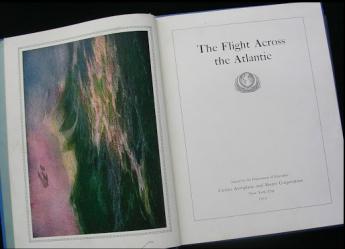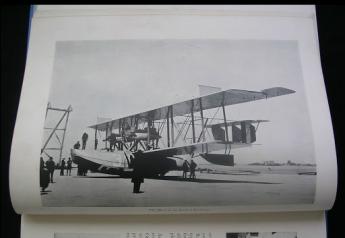Antiquarian Booksellers' Association of America Lighthouse Books, ABAA
Collecting Rare Books and First Editions - The First Flight Across the Atlantic

This week book lovers take their planes to New York to visit the 54th annual New York Antiquarian Book Fair at the Park Avenue Armory, which runs from 3rd to 6th April 2014. Michael Slicker commemorates the first flight across the Atlantic and the books written about it.
By Michael Slicker
A U.S. Mail pilot named Charles Lindbergh gets the credit for flying nonstop across the Atlantic Ocean by himself in 1927, and deservedly so, but he wasn’t the first to fly across the Atlantic.
That distinction goes to the crew of the Curtiss NC-4 floatplane, a name considerably less imaginative than the Spirit of St. Louis, and the feat took place in 1919, some eight years before Lucky Lindy’s historic excursion. A book about the accomplishment published the same year is in the collection of rare and unusual books at Lighthouse Books, ABAA. The Flight Across the Atlantic was issued by the federal Department of Education in 1919 under the auspicies of the Curtiss Aeroplane and Motor Corporation.
The trip took 19 days, including time for repairs and rest for the crew. Lindy’s hop took 33.5 hours. But, hey, these guys weren’t in any hurry and they weren’t carrying a load of mail.
It was a U.S. Navy project from the beginning and it was to demonstrate the plane’s transoceanic capabilities. The Curtiss floatplane was based on a design developed before World War I in Britain by a Royal Navy officer who was looking for a partner for a series of similar civilian planes. Curtiss then built them for the U.S. Navy and the Navy kept working to refine the design.
There were actually three planes that began the trip – NC-1, NC-3 and NC-4. There might have been a fourth, but the NC-2 had been cannibalized for spare parts for repairs to the NC-1.
The planes started at Naval Air Station Rockaway on Long Island and took a northerly route, making stops at Chatham Naval Air Station in Massachusetts and Halifax, Nova Scotia and Trepassey, Newfoundland, before continuing on the longest leg of the trip, a 1,200-nautical-mile flight to the Azores, in the middle of the Atlantic Ocean, opposite Portugal.
Naval planners, apparently a cautious lot, stationed ships every 50 miles or so along the route, with orders to be lighted up like a Hollywood extravaganza complete with searchlights, and to shoot starburst shells into the air so that the flyers could find their way across the dark ocean.
Despite their precautions, the NC-3 drifted off course into a fog bank and had to put down in the ocean short of its goal in the Azores. Fortunately, the crew rode the swells and the ship made it in under its own power. The NC-1, however, wasn’t so fortunate. It was rescued by a Greek freighter but sank three days later.
Only the NC-4 continued on to complete the mission and garner the fame.
Laid into this volume are several pieces of related ephemera that seem particularly to highlight Walter Hinton, the copilot of the NC-4; among other things, there is an envelope signed by him. Hinton, who lived until 1981, spent his retirement in Pompano Beach living in a beachfront condo and regaling local youngsters with tales of his exploits.
Are you collecting books on aeronautics?
>>> Browse the ILAB Metasearch
(Posted on the Lighthouse Books Blog, presented here by permission of the author.)

